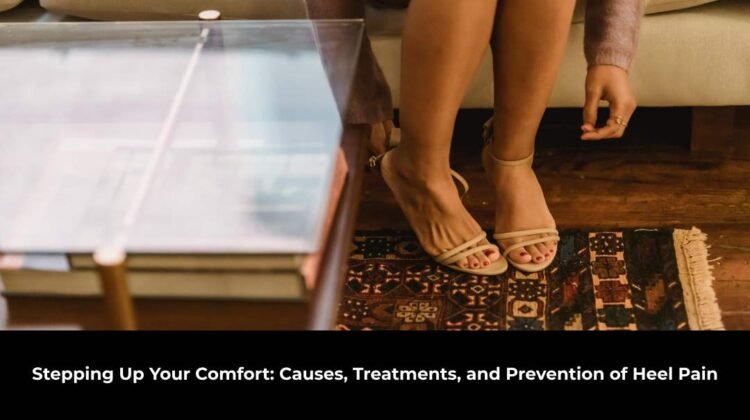
Heel pain – it can bring even the most enthusiastic walker to a standstill. But fear not, fellow foot travelers! Understanding the root of your discomfort is the first step to getting back on track. This article will explore the common culprits behind heel pain, along with effective treatments and preventative measures to keep you moving with ease.
Common Causes of Heel Pain
Understanding the cause of your heel pain is crucial for finding the most effective treatment. Let’s delve into some of the most frequent offenders:
- Plantar Fasciitis: This champion of discomfort takes the crown for most common cause. The plantar fascia, a band of tissue running along the bottom of your foot, endures a lot of stress. Microtears or inflammation in this area can lead to a stabbing pain, especially in the mornings.
- Achilles Tendinitis: Ever feel a tight, burning sensation at the back of your heel? This might be Achilles tendinitis, an irritation of the Achilles tendon that connects your calf muscle to your heel bone. Runners and people with tight calf muscles are more prone to this.
- Heel Bursitis: Bursae are fluid-filled sacs that cushion your joints. Inflammation in the bursa behind your heel can cause pain, especially when you put pressure on it.
Risk Factors for Heel Pain
Certain factors can increase your chances of developing heel pain. Here’s what to watch out for:
- Foot Mechanics: Flat feet, high arches, or an abnormal gait can put extra stress on your heel.
- Weight: Carrying extra pounds puts a strain on your entire body, including your heels.
- Improper Footwear: Shoes with poor arch support or those that are worn out can contribute to heel pain.
Treatments for Heel Pain
The good news is that there are effective treatments for heel pain! We’ll explore various options, from self-care techniques to medical interventions:
Home Care:
Taking care of your feet at home can significantly improve heel pain. Here are some simple yet effective strategies:
- Rest: Give your heels a break! Reduce activities that aggravate the pain.
- Ice: Apply ice packs to the affected area for 15-20 minutes at a time, several times a day.
- Stretching: Regularly stretching your calves and plantar fascia can improve flexibility and reduce pain.
Footwear and Other Foot Devices:
The shoes you wear play a vital role in foot health. Let’s look at how the right footwear can help alleviate heel pain:
- Foot-Shaped Shoes: Ditch the pointy stilettos! Opt for shoes with a wider toe box that allows your toes to spread naturally. This can help distribute pressure more evenly and reduce stress on your heels. Many foot-shaped shoes keep the padding to a minimum. This allows your foot to feel the ground more naturally, improving proprioception (your body’s awareness of its position in space) and strengthening the muscles in your feet. The concept of foot-shaped footwear for promoting overall foot health has been strongly endorsed by world-renowned podiatrist, Dr. Ray McClanahan.
- Toe Spacers: These small silicone or gel devices fit between your toes, gently nudging them back to a more natural position. This can improve alignment, stretch the plantar fascia, and strengthen the muscles in your feet. The best toe spacers are specifically designed to fit individual foot sizes and gently nudge your toes back to their natural, spread-out position. While research on their effectiveness for heel pain specifically is ongoing, some people find toe spacers to be a helpful addition to their overall foot care routine, particularly when combined with other treatments. If you’re searching for the perfect pair of toe spacers, you’ll encounter brands like Correct Toes, a leader in the market.
- Orthotics: Custom arch supports can provide extra support and improve your foot’s alignment.
Medical Intervention:
In some cases, medical intervention may be necessary to address heel pain. Here are some options to consider:
- Over-the-counter pain relievers: Nonsteroidal anti-inflammatory drugs (NSAIDs) like ibuprofen can help manage pain and inflammation.
- Corticosteroid injections: In severe cases, a doctor may inject corticosteroids directly into the inflamed area to reduce pain and swelling.
- Physical therapy: A physical therapist can design a personalized exercise program to strengthen the muscles supporting your heel and improve flexibility.
Conclusion
Heel pain doesn’t have to sideline you. By understanding the causes and taking proactive steps towards treatment and prevention, you can keep your feet feeling happy and your steps light. Remember, consulting a healthcare professional for a proper diagnosis and treatment plan is crucial, especially if the pain persists or worsens. With a little knowledge and the right approach, you’ll be back on your feet and exploring the world in comfort in no time!

